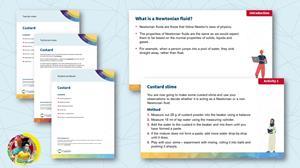Explore Newtonian and non-Newtonian fluids, surface area and rate of reaction
This experiment should take approximately one hour to complete in full. It was initially created for 11–14 year-old learners but can be adapted for other age groups.
Use the activities in a sequence of timetabled science lessons, STEM clubs or as part of a collapsed/off-timetable day.
Learning objectives
- Explain what a non-Newtonian fluid is.
- Describe conditions where powders may become explosive.
Guidance notes
Use the PowerPoint and teacher notes to recap states of matter. Introduce stress, strain, Newtonian and non-Newtonian fluids, providing examples to give learners context.
Activity 1: custard slime
In Activity 1, learners will work in pairs to make custard slime by mixing water and custard powder. If time and resources are available, the learners could complete this activity individually. Once learners have made their slime, they will use it to answer questions a and b in their student workbooks. Learners will return to discuss their results, which is a good point to explain the idea of the viscosity (fluidity) being related to the amount of stress the slime is under.
Activity 1: custard bomb demonstration
In Activity 2, learners will observe the custard bomb demonstration. Introduce the demo using the video on slide 12 of the PowerPoint, also available on National Geographic’s YouTube channel. If you are unable to perform the demonstration, replay the video to enable learners to answer the questions. Learners will record their observations and answer questions a to c in their student workbooks evaluating the demonstration and suggesting improvements to the experiment.
If time is available, learners could explore the properties of non-Newtonian fluids further in the ‘What is the best way to escape from quicksand?’ activity available in the Quicksand student workbook.
Find the answers to the activities in the teacher notes and slides.

This resource was developed as part of the Chemistry for All project. The project was set up to explore and address barriers to participation in UK chemistry undergraduate study through a longitudinal project. Read the findings relevant to teachers, outreach providers, education policymakers and parents in the summary report, or download the full research report.
Health and safety
Read our health and safety guidance and carry out a risk assessment before running any live practical.
The safety equipment suggested is in line with CLEAPSS requirements. For non-hazardous substances, wearing lab coats can help to protect clothes. The safety rules might be different where you live so it is worth checking local and school guidance.
Always practise the custard bomb demonstration in advance. CLEAPSS members should consult SRA002. The quantities and method used should be as outlined in the teacher notes and not deviated from. Use safety screens to protect the demonstrator and audience. The safety screens should be positioned close to the can so that the lid is only able to escape vertically. Wear eye protection and learners must be at least 2–3 metres away.
More resources
- Develop your learners’ practical planning skills through spotting mistakes in practical experiments.
- Get your 11–14 learners comfortable with the concept of states of matter using a microscale diffusion experiment.
- Review your 14–16 learners’ understanding of the particle model with student worksheets, available with or without scaffolding, and teacher guidance with answers.
Careers
The Chemistry for All project found that recognising the value and importance of chemistry, and appreciating how chemistry can lead to interesting and well-paid jobs strongly related to learners’ future aspirations. Discover how chemistry can prepare learners to pursue apprenticeships, university courses and vocational routes, or browse job profiles and try our career options game from A Future in Chemistry.
Watch Robert’s video job profile on slide 15 of the PowerPoint to link the properties and uses of non-Newtonian fluids to careers. Robert is a consumer products technician and uses his understanding of materials, such as non-Newtonian fluids, to develop desirable properties for consumer products, including cosmetics, adhesives and cleaning products.
Find more activities like this, plus longer projects suitable for off-timetable days, science lessons or clubs on our Outreach resources hub.
Downloads
Custard student workbook
Editable handout | Word, Size 0.47 mbCustard student workbook
Handout | PDF, Size 0.37 mbCustard teacher notes
Editable handout | Word, Size 0.49 mbCustard teacher notes
Handout | PDF, Size 0.5 mbCustard technician notes
Editable handout | Word, Size 0.47 mbCustard technician notes
Handout | PDF, Size 0.36 mbCustard presentation slides
Presentation | PowerPoint, Size 1.74 mbCustard presentation slides
Presentation | PDF, Size 1.4 mb
Additional information
This resource was originally developed by the University of Reading to support outreach work delivered as part of the Chemistry for All project.



















No comments yet